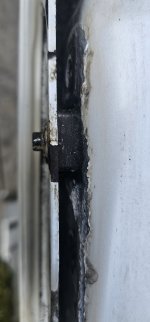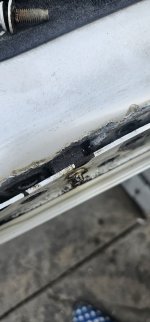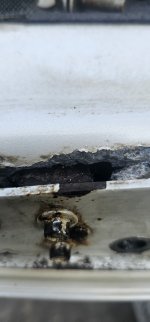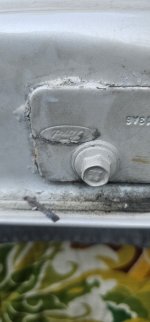This is a pretty interesting video showing off a Canadian Ford F-150 with the aluminum body after 250k KM. Not surprising to me, but you know, the planned obsolescence crowd is going to have a field day with this one.
You are using an out of date browser. It may not display this or other websites correctly.
You should upgrade or use an alternative browser.
You should upgrade or use an alternative browser.
Aluminum F-150 rust update after 250k KM
- Thread starter testerdahl
- Start date
I think that thing looks pretty good for a 9yr old vehicle. And I agree, the steel under carriage will rust, that's a given. It's the rusting fenders, rocker panels, and bed floors that just ruin the truck. That body looks awesome compared to my steel fenders/rockers/bumpers. My frame and undercarriage looks about the same. Good job Ford, I can't knock it.
Blue Oval 5.0
Active member
Watched the first 11 mins and my initial thoughts are that I recall a lot of doubt and concern when Ford went to the aluminum body. This was a huge risk and it was successful as many other automakers began to use aluminum panels to save weight. And this was five years after Ford took a huge risk introducing the EcoBoost engines in the F-150.
My 2008 has rust in the front dog leg and on the bedside above the wheel arches which is typical of that generation. Going to aluminum seven years later solved those problems it seems.
My 2008 has rust in the front dog leg and on the bedside above the wheel arches which is typical of that generation. Going to aluminum seven years later solved those problems it seems.
GMT 900
Well-known member
Saw the piece the other day. Good work, except he didn't explain why steel and aluminum together is not good: Galvanic CorrosionThis is a pretty interesting video showing off a Canadian Ford F-150 with the aluminum body after 250k KM. Not surprising to me, but you know, the planned obsolescence crowd is going to have a field day with this one.
Here is a piece Popular Mechanics did on the 2015 Aluminum Body F-150
https://www.popularmechanics.com/ca...rture-tested-its-new-aluminum-f-150-16682803/
Key Point:
"The physical geometry of the metal is the easy part with aluminum. The bigger challenge is dealing with and testing for galvanic corrosion. Galvanic corrosion is not like the red rust we're used to with steel-bodied cars, where environmental oxygen chemically bonds with iron atoms to form iron oxide. Galvanic corrosion takes place through the exchange of ions between metals bathed in an electrolyte. In essence, any time dissimilar metals are placed in physical contact, a battery is created, and the atoms in contact exchange metallic ions and degrade the actual atoms at the surface. Over time this creates pitting and metal fatigue.
Ford is fighting this process by electrocoating the aluminum panels to electrically and physically isolate the metals, and by using new coatings on all body bolts. To test the long-term durability of these kinds of joints, engineers normally bathe body panels in a saltwater spray during a hot/cold environmental cycle—this encourages the formation of iron oxide. But with aluminum that was just too slow. So they switched to a corrosive acid bath and found that tweaking the metallic coating on the bolts protected the metal admirably.
If Ford has done its work properly, then bodies on these trucks will outlast every other part. This has lead to some interesting work on the subject of end-of-life recycling, but it removes any concern about a tailgate or fender or cab corner ever rusting through."
No planned obsolescence? You still get it with a Ford Engine, Ford Transmission, and Ford Rear Axle
I remember all the concern and talk about using different metals with galvanic corrosion. Starting to look like that concern isn’t coming to fruition.Saw the piece the other day. Good work, except he didn't explain why steel and aluminum together is not good: Galvanic Corrosion
Here is a piece Popular Mechanics did on the 2015 Aluminum Body F-150
https://www.popularmechanics.com/ca...rture-tested-its-new-aluminum-f-150-16682803/
Key Point:
"The physical geometry of the metal is the easy part with aluminum. The bigger challenge is dealing with and testing for galvanic corrosion. Galvanic corrosion is not like the red rust we're used to with steel-bodied cars, where environmental oxygen chemically bonds with iron atoms to form iron oxide. Galvanic corrosion takes place through the exchange of ions between metals bathed in an electrolyte. In essence, any time dissimilar metals are placed in physical contact, a battery is created, and the atoms in contact exchange metallic ions and degrade the actual atoms at the surface. Over time this creates pitting and metal fatigue.
Ford is fighting this process by electrocoating the aluminum panels to electrically and physically isolate the metals, and by using new coatings on all body bolts. To test the long-term durability of these kinds of joints, engineers normally bathe body panels in a saltwater spray during a hot/cold environmental cycle—this encourages the formation of iron oxide. But with aluminum that was just too slow. So they switched to a corrosive acid bath and found that tweaking the metallic coating on the bolts protected the metal admirably.
If Ford has done its work properly, then bodies on these trucks will outlast every other part. This has lead to some interesting work on the subject of end-of-life recycling, but it removes any concern about a tailgate or fender or cab corner ever rusting through."
No planned obsolescence? You still get it with a Ford Engine, Ford Transmission, and Ford Rear Axle
GMT 900
Well-known member
I remember all the concern and talk about using different metals with galvanic corrosion. Starting to look like that concern isn’t coming to fruition.
The Battleship USS New Jersey (BB-62) is almost to her dry-dock (same one she was built in the early 40s!) and five months ago, the ship's curator highlighted one of the reason's why they need to dry dock her at Time Stamp 6:18. So aluminum will now be sacrificed to corrode. Ford should have donated the anodes to come full circle.
Yep. And remember all the crap about how much more expensive bodywork was going to be? Like anything is cheap bodywork anymore. It's all designed to crumple and be replaced. I wasn't a Ford fan, but I fully admitted that it was a great idea long in coming. Same with the composite beds, great idea.Watched the first 11 mins and my initial thoughts are that I recall a lot of doubt and concern when Ford went to the aluminum body. This was a huge risk and it was successful as many other automakers began to use aluminum panels to save weight. And this was five years after Ford took a huge risk introducing the EcoBoost engines in the F-150.
My 2008 has rust in the front dog leg and on the bedside above the wheel arches which is typical of that generation. Going to aluminum seven years later solved those problems it seems.
Matersf150
New member
This is the tailgate on my 2016. Bought brand new. Only found this corrosion because I needed to replace the tailgate torsion rod. Needless to say, Ford is not offering any help. $2200 to replace it. I'll wait until it falls off and the NTHSA demands ford recall the tailgates when they start falling off the trucks.I remember all the concern and talk about using different metals with galvanic corrosion. Starting to look like that concern isn’t coming to fruition.





